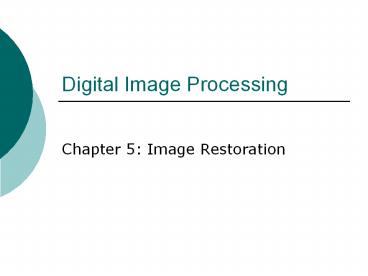Digital Image Processing - PowerPoint PPT Presentation
Title:
Digital Image Processing
Description:
Digital Image Processing Chapter 5: Image Restoration A Model of the Image Degradation/Restoration Process Degradation Degradation function H Additive noise Spatial ... – PowerPoint PPT presentation
Number of Views:1402
Avg rating:3.0/5.0
Title: Digital Image Processing
1
Digital Image Processing
- Chapter 5 Image Restoration
2
A Model of the Image Degradation/Restoration
Process
3
- Degradation
- Degradation function H
- Additive noise
- Spatial domain
- Frequency domain
4
- Restoration
5
Noise Models
- Sources of noise
- Image acquisition, digitization, transmission
- White noise
- The Fourier spectrum of noise is constant
- Assuming
- Noise is independent of spatial coordinates
- Noise is uncorrelated with respect to the image
itself
6
- Gaussian noise
- The PDF of a Gaussian random variable, z,
- Mean
- Standard deviation
- Variance
7
- 70 of its values will be in the range
- 95 of its values will be in the range
8
- Rayleigh noise
- The PDF of Rayleigh noise,
- Mean
- Variance
9
(No Transcript)
10
- Erlang (Gamma) noise
- The PDF of Erlang noise, , is a
positive integer, - Mean
- Variance
11
- Exponential noise
- The PDF of exponential noise, ,
- Mean
- Variance
12
- Uniform noise
- The PDF of uniform noise,
- Mean
- Variance
13
- Impulse (salt-and-pepper) noise
- The PDF of (bipolar) impulse noise,
- gray-level will appear as a light
dot, while level will appear like a dark dot - Unipolar either or is zero
14
- Usually, for an 8-bit image, 0 (black) and
0 (white)
15
- Modeling
- Gaussian
- Electronic circuit noise, sensor noise due to
poor illumination and/or high temperature - Rayleigh
- Range imaging
- Exponential and gamma
- Laser imaging
16
- Impulse
- Quick transients, such as faulty switching
- Uniform
- Least descriptive
- Basis for numerous random number generators
17
(No Transcript)
18
(No Transcript)
19
(No Transcript)
20
- Periodic noise
- Arises typically from electrical or
electromechanical interference - Reduced significantly via frequency domain
filtering
21
(No Transcript)
22
- Estimation of noise parameters
- Inspection of the Fourier spectrum
- Small patches of reasonably constant gray level
- For example, 15020 vertical strips
- Calculate , , , from
23
(No Transcript)
24
Restoration in the Presence of Noise Only-Spatial
Filtering
- Degradation
- Spatial domain
- Frequency domain
25
- Mean filters
- Arithmetic mean filter
- Geometric mean filter
26
- Harmonic mean filter
- Works well for salt noise, but fails fpr pepper
noise
27
- Contraharmonic mean filter
- eliminates pepper noise
- eliminates salt noise
28
(No Transcript)
29
(No Transcript)
30
- Usage
- Arithmetic and geometric mean filters suited for
Gaussian or uniform noise - Contraharmonic filters suited for impulse noise
31
(No Transcript)
32
- Order-statistics filters
- Median filter
- Effective in the presence of both bipolar and
unipolar impulse noise
33
- Max and min filters
- max filters reduce pepper noise
- min filters salt noise
34
- Midpoint filter
- Works best for randomly distributed noise, like
Gaussian or uniform noise
35
- Alpha-trimmed mean filter
- Delete the d/2 lowest and the d/2 highest
gray-level values - Useful in situations involving multiple types of
noise, such as a combination of salt-and-pepper
and Gaussian noise
36
(No Transcript)
37
(No Transcript)
38
(No Transcript)
39
- Adaptive, local noise reduction filter
- If is zero, return simply the value of
- If , return a value close to
- If , return the arithmetic mean
value
40
(No Transcript)
41
- Adaptive median filter
- minimum gray level value in
- maximum gray level value in
- median of gray levels in
- gray level at coordinates
- maximum allowed size of
42
- Algorithm
- Level A A1
- A2
- If A1gt0 AND A2lt0, Go to
- level B
- Else increase the window size
- If window size
- repeat level
A - Else output
43
- Level B B1
- B2
- If B1gt0 AND B2lt0, output
- Else output
44
- Purposes of the algorithm
- Remove salt-and-pepper (impulse) noise
- Provide smoothing
- Reduce distortion, such as excessive thinning or
thickening of object boundaries
45
(No Transcript)
46
Periodic Noise Reduction by Frequency Domain
Filtering
- Bandreject filters
- Ideal bandreject filter
47
- Butterworth bandreject filter of order n
- Gaussian bandreject filter
48
(No Transcript)
49
(No Transcript)
50
- Bandpass filters
51
(No Transcript)
52
- Notch filters
- Ideal notch reject filter
53
- Butterworth notch reject filter of order n
54
- Gaussian notch reject filter
55
(No Transcript)
56
- Notch pass filter
57
(No Transcript)
58
- Optimum notch filtering
59
- Interference noise pattern
- Interference noise pattern in the spatial domain
- Subtract from a weighted portion of
to obtain an estimate of
60
- Minimize the local variance of
- The detailed steps are listed in Page 251
- Result
61
(No Transcript)
62
(No Transcript)
63
(No Transcript)
64
(No Transcript)
65
(No Transcript)
66
(No Transcript)
67
(No Transcript)
68
(No Transcript)
69
(No Transcript)
70
(No Transcript)
71
(No Transcript)
72
(No Transcript)
73
(No Transcript)
74
(No Transcript)
75
(No Transcript)
76
(No Transcript)
77
(No Transcript)
78
(No Transcript)
79
(No Transcript)































